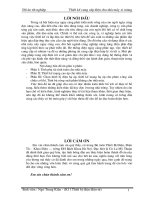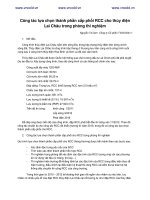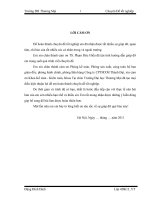chỉ dẫn chọn cấp phối bt xi măng
Bạn đang xem bản rút gọn của tài liệu. Xem và tải ngay bản đầy đủ của tài liệu tại đây (340.73 KB, 4 trang )
Concrete Property Test
Strength Development 2-3:
Set Time
www.cptechcenter.org
Purpose – Why Do This Test?
Test Method
Determining the set time of a concrete mixture during the
mixture design and mixture verification phases enables
comparison of the mixture’s early strength development
characteristics. Such a comparison may reveal changes in the
mixture’s behavior and properties as compared to what was
observed during the mixture design stage. Early identification
of strength development trends may be helpful in preventing
uncontrolled cracking in the pavement.
1. Prepare a lab mortar sample or obtain a mortar sample
from a field-mixed batch.
2. Record the time at which cementitious materials first
come into contact with water.
continued on next page
Principle – What is the Theory?
The hydration process for a given concrete mixture is complex
and dependent on the interaction of many factors (materials
and processes). Set time testing identifies two points on the
hydration curve: initial set and final set. Initial set occurs at
500 lb/in2 (penetration resistance) and final set is defined to
occur at 4,000 lb/in2 (penetration resistance). Even though
the initial and final set values are arbitrary and may not have
any connection to field behavior of the pavement, these test
values provide an objective measure of the concrete mixture’s
early strength development characteristics.
Test Procedure – How is the Test Run?
ASTM C 403, the Standard Test Method for Time of Setting
of Concrete Mixtures by Penetration Resisitance, determines
the penetration resistance (expressed in lb/in2) of a mortar
sample over time. Penetration resistance is a function of
the force required for a needle of known bearing area to
penetrate a curing mortar sample to a depth of 1 in. A penetrometer with varying size needles is used to determine the
penetration resistance.
Test Apparatus (figure 1)
• Container for mortar specimen(s).
• Penetration needles with the following bearing areas
(in2):1.00, 0.50, 0.25, 0.05, 0.025.
• Penetrometer.
• Tamping rod.
• Pipet.
• Thermometer.
• Vibratory mortar sampler (suggested for field sampling).
CP Tech Center
I
Iowa State University
Figure 1. Set time testing equipment
FOR MORE INFORMATION
I
2711 S. Loop Dr. Suite 4700, Ames, IA 50010-8664
I
515-294-5798
Strength Development 2-3: Set Time, continued
3. Record the temperature of the fresh mortar sample, place
in a container, consolidate, and level the top surface of the
mortar.
4. Maintain the ambient test conditions at 68ºF to 77ºF (lab
and field tests).
5. Begin penetration testing approximately 3 to 4 hours
after initial contact between the cement and water.
Continue penetration testing at 30 to 60 minute intervals,
decreasing the needle bearing area as necessary, until
final set of 4,000 lb/in2 occurs.
6. For each penetration, record the ambient temperature,
mortar temperature, force, and bearing area.
7. Calculate the penetration resistance by dividing the force
by the penetration area.
8. Plot the results.
2
Output – How Do I Interpret the Results?
Plot the set time for mixture design and mixture verification
tests together (figure 2). Compare the results and note
whether the field-mixed concrete has significantly different set
time characteristics than the mixture design.
Construction Issues – What Should
I Look For?
Delays in normal setting may lead to uncontrolled cracking as
stresses build up in the pavement before it has time to gain
enough strength for sawcutting operations. This is especially
critical in hot and/or dry weather conditions. Accelerated set
will require earlier sawcutting operations.
Strength Development 2-3: Set Time, continued
Penetration Resistance ASTM C 403
Project:
Test description:
Date:
Time:
Operator:
I-35 Payne Co.
Mixture verification
29-May-08
9:10 AM
BZ
Time
Air/mortar
temperature (ºF)
Elapsed time
Needle #
Reading (lb)
Penetration
resistance (lb/in2)
Log (PR)
Log (f)
12:50 PM
69.0/73.2
220
1
112
112
2.05
2.34
1:50 PM
69.4/74.3
280
2
175
350
2.54
2.45
2:20 PM
69.5/74.8
310
4
198
792
2.90
2.49
2:50 PM
70.3/76.7
340
10
120
1,200
3.08
2.53
3:20 PM
71.1/78.8
370
20
75
1,500
3.18
2.57
3:40 PM
71.6/79.9
390
40
55
2,200
3.34
2.59
4:10 PM
72.3/80.2
420
40
80
3,200
3.51
2.62
4:40 PM
72.1/81.6
450
40
115
4,600
3.66
2.65
Initial set (at 500 lb/in2)
2
Final set (at 4,000 lb/in )
estimated times
based on test data
290 min
4.84 h
452 min
7.53 h
Penetration resistance (lb/in2)
10,000
FS
1,000
IS
100
100
1,000
Elapsed time (min)
Example mixture design
Example mixture verification
Initial Set (IS) typical window
Final Set (FS) typical window
____________________________________________________________________________________________________________________
Figure 2. Plotting set time for mixture design and mixture verification
3
APRIL 2008
This test summary is one of a set of summaries originally published
in chapter 7 of the Testing Guide for Implementing Concrete Paving
Quality Control Procedures (Fick, G., Iowa State University, Ames, Iowa,
2008). The testing guide is a product of a 17-state, Federal Highway
Administration pooled-fund project, Material and Construction
Optimization for Prevention of Premature Pavement Distress in PCC
Pavements, TPF-5(066). The project was managed by the National
Concrete Pavement Technology Center at Iowa State University.
Any opinions, findings, and conclusions or recommendations expressed
in this material are those of the authors and do not necessarily reflect
the view of Federal Highway Administration or Iowa State University.
Iowa State University does not discriminate on the basis of race, color,
age, religion, national origin, sexual orientation, gender identity, sex,
marital status, disability, or status as a U.S. veteran. Inqueries can be
directed to the Director of Equal Opportunity and Diversity, Iowa State
University, 3680 Beardshear Hall, 515-294-7612.









